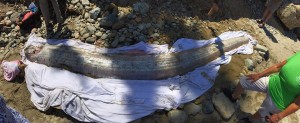 Dr. Misty Paig-Tran is Assistant Professor at California State University Fullerton. Her laboratory (Functional Anatomy, Biomechanics, and Biomaterials) studies how animals feed and move, among other things. Her research is focused on big filter-feeding animals (Sharks and Manta rays) and mid-deep water fishes – you know, the scary looking ones. You can learn about her research here, and you can follow her on twitter.
Dr. Misty Paig-Tran is Assistant Professor at California State University Fullerton. Her laboratory (Functional Anatomy, Biomechanics, and Biomaterials) studies how animals feed and move, among other things. Her research is focused on big filter-feeding animals (Sharks and Manta rays) and mid-deep water fishes – you know, the scary looking ones. You can learn about her research here, and you can follow her on twitter.
Today I sit at my computer totally aghast that the media seems to have gone into a frenzy once again about the latest oarfish that washed up on Catalina yesterday. I get it. I too, as a marine biologist and self-admitted fish nerd, get totally excited any time a cool fish washes up. And I get extra excited about the oarfish in particular. Of course I do, I am currently studying the fish in my lab at Cal State. What’s not to like? It’s huge, silvery, and looks like a dragon. Myths about this fish are old and salty. However, there has been a ton of misinformation printed about this fish and now it’s my chance to set some things straight. So I will try to rectify this now. Ahem.
- Myth 1: The oarfish can grow up to 110 ft
– Nope. That’s bigger than a blue whale, the largest animal to ever roam the Earth. Oarfish have been documented at about 8 m or roughly 24 ft. There are some rumors of them getting up to thirty feet but you’ll be hard pressed to actually find it well documented.
- Myth 2: Oarfish are mammals
– Oarfish are fish. They are not mammals. Period.
- Myth 3: The scientists couldn’t find the ears
– No, we look for a little bony structure called an otolith (which does translate to ear bone) to try to age the fish much like you can age a tree using the rings. Oarfish don’t have much calcium in their bones so they appear to not have these structures. I’ll come back to this lack of calcium thing.
- Myth 4: The oarfish wash up prior to an earthquake
– Well they might, but it is likely unrelated. All three of these fish washed up with no major seismic activity following suit. Fun note – lots of deep sea fish surface after an earthquake if there is a tsunami.
- Myth 5: That thing looks dangerous
– Okay okay, this is more of a comment than a myth, but it’s the comment I heard most while dissecting on the beach. But I will clarify that it is a harmless filter-feeder and it is highly unlikely that you will ever come in contact with a live one anyhow since they live deeper than you can swim.
- Myth 6: The oarfish was longer by 7 feet
– No. It was missing part of its tail, but this is common for any oarfish stranded that is over roughly 10 ft. long. Based on my calculation, it was missing maybe a foot of its tail.
- Myth 7: The oarfish stranded because of naval testing
– While it may be the case, the fish had no major trauma (bruising) to the body. Everything looked pretty healthy. Probably not the reason it surfaced.
- Myth 8: Fukushima
– No.
- Myth 9: Plastics killed the fish
– I didn’t find any evidence of plastic in its gut.
Now lets shift gears and talk about some cool facts about the oarfish. Maybe I can get the True Facts guy to read this aloud.
- Oarfish are the longest bony fish in the ocean at about 26 feet. This is different from saying they are the biggest fish. For example: Black Sea Bass can grow to be over 550 lbs but only around 8 feet long. Whale sharks are the biggest fish in the ocean period, but they have no bones. So there’s that. Their skeletons are entirely made of cartilage. Go ahead and feel your nose. Grab a good handful of nose and twist. Yep. Whale sharks are made out of that stuff.
- Oarfish are super shiny when they are alive. In fact, They are almost shiny enough to see your reflection. Almost. Also their fins are bright red when alive. They really are gorgeous.
- Oarfish are related to another weird fish called Opah. This is the only known fish to be warm blooded. Oarfish are not warm blooded as far as we can tell.
- Oarfish can drop the end of their tail like a lizard does. Their vertebrae just breaks off right down the center. Snap. Tail gone. When and why they do this is not known. Most of the fish I have looked at have had a portion of their tail missing. The bone is totally exposed and there is evidence of healing. Some reports have stated that they even break apart in people’s hands. This has yet to happen to me.
- Adult female oarfish have two ovaries that together can weigh about 20 lbs. Imagine carrying that around. The females have millions of eggs. Right now we have an undergrad counting them in lab. Be thankful you are not that person.
- Male oarfish have puny testes. I mean, these things are smaller than testes in fish a quarter of their size. It turns out that they don’t have to lug around big testes to produce a lot of semen. – My apologies if you didn’t want to know this much detail about oarfish breeding.
- Oarfish are probably not strong swimmers. All video of live oarfish indicate that they mostly stay put in the ocean and just feed on krill (little shrimp like things). There is a nice science Friday video of oarfish you can watch to see them swim. Full disclosure, I’m in the video too and yes this is a shameless plug for my lab. – Also look up Science Friday’s manta ray feeding video, but I digress…
- We don’t know how old these washed up fish actually are. But we are working on figuring it out. We should be able to start estimating age and growth within the year.
- Why do these fish keep washing up? My best guess is that changing ocean currents are bringing them up to the surface. Once there, they can’t swim back down. Remember point #7, they are weak swimmers. Rough seas are hard to fight against. It’s El Nino. Things are wonky here off California right now. Remember we had whale sharks and mantas show up off Catalina last year. Blue fin tuna are in the area. Insanity.
- Oarfish have no scales. Instead they have little bumps called tubercles running the length of their body.
- Oarfish bodies are kind of like jelly. You can use a regular steak knife to cut through the whole 14 ft fish – I know because that’s what I did. Really. Even through bone.
- Speaking of the bone, you can hold oarfish bone up to the light and pretty much see through it. No not like a clear window, but like a winter window covered by an icy coating. It has very little calcium except in a few select spots. Calcium helps to make those bones the whitish grey color that you are probably used to.
I hope this answers some of your questions about oarfish. If I didn’t answer your question you can always ask me on Twitter @FABBLab.

So I have wondered if oarfish have teeth or other bony tissue in their mouths?
Hi Dr. Paig-Tran, I was there in the early morning around 8:45am and was able to experience this Beautiful Fish. I noticed part of the Lower Jaw damaged/missing. And also missing were the long Pelvic Fins, they were down to about 3″ nubs. Could this Oarfish have been deceased for some days and it had been decomposing some what? There was also about a 6″ flesh exposure maybe 6′ Feet behind the head, could fish have been feeding off of it?
Thank you,
Looking forward to your reply…
Armando Gonzalez
Avid Angler
Doug: They do not have large teeth, instead they have a crazy weird mouth that we are currently studying – because it works unlike any other fish I’ve seen. It eats tiny prey smaller than a pencil eraser, so teeth are not a necessity.
Armando: I’m happy to hear you got to see this beauty. The lower jaw actually folds up into the upper jaw. It was actually present, but in rough shape from the sand – this happens when the fish beach. You are correct, the pelvic fins also appear to have gotten beaten up with the beaching. The fish showed no signs of decomposition and , in fact, the fins were still red and the skin silvery. This only stays for the first few hours after they die, hence how I estimated the time of death was the early am. You saw it super fresh! The chunk you mentioned is actually from a cookie cutter shark. This is a teeny tiny shark that takes little round bites out of lots of fish including tunas, etc. That’s a great observation you made. I too was excited by the small bite mark – though this would not have been the cause of death.
All the best – Misty Paig-Tran
The oarfish is one of the most mysterious fish on earth. Years ago i saved an article about a family vacation trip to san markos island (sp) in mexico. The post showed a series of pictures of two oarfish, one female and the other male (with a crest). Both were swimming in the cove with their heads out of the water..
The female sank out and settled on the sandy bottom, the male went to the outcropping he saw and kicked himself up on the rocks and expired…
What would make this pair come up from the depths and both parrish together? Unfortunately the web page finally removed that post….
I would really like to hear your thoughts on oarfish suicides–Seldom, do the ones found on the beach actually show signs of decomposition, so they must have gotten themselves there for a purpose… I have also read that they will remove part of their own tail when it starts to decompose…
I love a good mystery, like how 3 manta rays can stay together for a thousand miles, day and night..